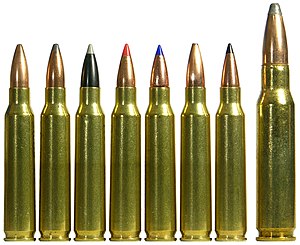.223 Remington
| .223 Remington | ||||||||||||||||||||||||
|---|---|---|---|---|---|---|---|---|---|---|---|---|---|---|---|---|---|---|---|---|---|---|---|---|

A variety of .223 Remington cartridges and a .308 Winchester (right) for comparison. Bullets in .223 cartridges (left to right): Montana Gold 55 grain Full Metal Jacket, Sierra 55 grain Spitzer Boat Tail, Nosler/Winchester 55 grain Combined Technology, Hornady 60 grain V-MAX, Barnes 62 grain Tipped Triple-Shock X, Nosler 69 grain Hollow Point Boat Tail, Swift 75 grain Scirocco II.
|
||||||||||||||||||||||||
| Type | Rifle | |||||||||||||||||||||||
| Place of origin | United States | |||||||||||||||||||||||
| Production history | ||||||||||||||||||||||||
| Designer | Remington Arms | |||||||||||||||||||||||
| Designed | 1962 | |||||||||||||||||||||||
| Produced | 1964–present | |||||||||||||||||||||||
| Variants | .223 Ackley Improved, 5.56×45mm NATO | |||||||||||||||||||||||
| Specifications | ||||||||||||||||||||||||
| Parent case | .222 Remington | |||||||||||||||||||||||
| Case type | Rimless, bottleneck | |||||||||||||||||||||||
| Bullet diameter | 0.224 in (5.7 mm) | |||||||||||||||||||||||
| Neck diameter | 0.253 in (6.4 mm) | |||||||||||||||||||||||
| Shoulder diameter | 0.354 in (9.0 mm) | |||||||||||||||||||||||
| Base diameter | 0.376 in (9.6 mm) | |||||||||||||||||||||||
| Rim diameter | 0.378 in (9.6 mm) | |||||||||||||||||||||||
| Rim thickness | 0.045 in (1.1 mm) | |||||||||||||||||||||||
| Case length | 1.76 in (45 mm) | |||||||||||||||||||||||
| Overall length | 2.26 in (57 mm) | |||||||||||||||||||||||
| Rifling twist | 1 in 12 inch (military style rifles use 1:7 to 1:10 to stabilize longer bullets) | |||||||||||||||||||||||
| Primer type | Small rifle | |||||||||||||||||||||||
| Maximum pressure (SAAMI) | 55,000 psi (380 MPa) | |||||||||||||||||||||||
| Maximum pressure (CIP) | 62,366 psi (430.00 MPa) | |||||||||||||||||||||||
| Maximum CUP | 52000 CUP | |||||||||||||||||||||||
| Ballistic performance | ||||||||||||||||||||||||
|
||||||||||||||||||||||||
|
Test barrel length: 24 inches (61 cm) Source(s): Federal Cartridge |
||||||||||||||||||||||||
The .223 Remington (.223 Rem) is a cartridge with almost the same external dimensions as the 5.56×45mm NATO military cartridge. The name is commonly pronounced either two-two-three or two-twenty-three Remington. It is loaded with a 0.224-inch (5.56 mm) diameter jacketed bullet, with weights ranging from 40 to 90 grains (2.6 to 5.8 g), though the most common loading by far is 55 grains (3.6 g). While the external case dimensions are very similar, the .223 Remington and 5.56×45mm differ in both maximum pressure and chamber shape. The maximum and mean pressures for some varieties of the 5.56 (different cartridge designations have different standards) exceed the SAAMI maximum for the .223 Remington, and the methods for measuring pressures differ between NATO and SAAMI. The 5.56 chamber specification has also changed since its adoption, as the current military loading (NATO SS-109 or US M855) uses longer, heavier bullets than the original loading. This has resulted in a lengthening of the throat in the 5.56 chamber. Thus, while .223 Remington ammunition can be safely fired in a rifle chambered for 5.56×45mm NATO, firing 5.56 ammunition in a .223 Remington chamber may produce pressures in excess of even the 5.56 specifications due to the shorter throat.
During the late 1950s, ArmaLite and other U.S. firearm designers started their individual Small Caliber/High Velocity (SCHV) rifle experiments using the commercial .222 Remington cartridge. When it became clear that there was not enough case capacity to meet U.S. Continental Army Command's (CONARC) velocity and penetration requirements, ArmaLite contacted Remington to create a similar cartridge with a longer case body and shorter neck. This became the .222 Special. At the same time, Springfield Armory's Earle Harvey had Remington create an even longer cartridge case then known as the .224 Springfield. Springfield was forced to drop out of the CONARC competition, and thus the .224 Springfield was released in 1958 as a commercial sporting cartridge known as the .222 Remington Magnum. To prevent confusion among all of the competing .222 cartridge designations, the .222 Special was renamed the .223 Remington in 1959. In the spring of 1962 Remington submitted the specifications of the .223 Remington to the Sporting Arms and Ammunition Manufacturers' Institute (SAAMI). With the U.S. military adoption of the M16 assault rifle in 1963, the .223 Remington in a slightly derived form was standardized as the 5.56×45mm NATO. As a commercial sporting cartridge the .223 Remington was introduced in 1964.
...
Wikipedia
